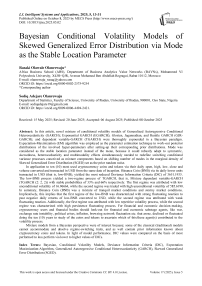Bayesian Conditional Volatility Models of Skewed Generalized Error Distribution via Mode as the Stable Location Parameter
Автор: Rasaki Olawale Olanrewaju, Sodiq Adejare Olanrewaju
Журнал: International Journal of Intelligent Systems and Applications @ijisa
Статья в выпуске: 5 vol.17, 2025 года.
Бесплатный доступ
In this article, novel mixture of conditional volatility models of Generalized Autoregressive Conditional Heteroscedasticity (GARCH); Exponential GARCH (EGARCH); Glosten, Jagannathan, and Runkle GARCH (GJR-GARCH); and dependent variable-GARCH (TGARCH) were thoroughly expounded in a Bayesian paradigm. Expectation-Maximization (EM) algorithm was employed as the parameter estimation technique to work-out posterior distributions of the involved hyper-parameters after setting-up their corresponding prior distributions. Mode was considered as the stable location parameter instead of the mean, because it could robustly adapt to symmetric, skewedness, heteroscedasticity and multimodality effects simulteanously needed to redefine switching conditional variance processes conceived as mixture components based on shifting number of modes in the marginal density of Skewed Generalized Error Distribution (SGED) set as the prior random noise. In application to ten (10) most used cryptocurrency coins and tokens via their daily open, high, low, close and volume converted and transacted in USD from the same date of inception. Binance Coin (BNB) via its daily lower units transacted in USD (that is, low-BNB), yielded the most reduced Deviance Information Criteria (DIC) of 3651.1935. The low-BNB process yielded a two-regime process of TGARCH, that is, Mixture dependent variable-GARCH (TGARCH (2: 2, 2)) with stable probabilities of 33% and 66% respectively. The first regime was attributed with low unconditional volatility of 16.96664, while the second regime was traded with high unconditional volatility of 585.6190. In summary, Binance Coin (BNB) was a mixture of tranquil market conditions and stormy market conditions. Implicatively, this implies that the first regime of the low-BNB was characterized with strong fluctuating reaction to past negative daily returns of low-BNB converted to USD, while the second regime was attributed with weak fluctuating reaction. Additionally, the first regime was attributed with low repetitive volatility process, while the second regime was characterized with high persistence fluctuating process. For financial and economic decision-making, crypocurrency users and financial bodies should look-out for financial and economic sabotage agents, like war, exchange rate instability, political crises, inflation, browsing network fluctuation etc. that arose, declined or fluctuated doing the ten (10) years to study of the coins and tokens to ascertain which of this/these agent(s) contributed to the volatility process. Mixture models from a Bayesian perspective were of interest because; some of the classical (traditional) models cannot accommodate and absolve regime-switching traits, and as well contain prior information known about cryptocurrency coins and tokens. In light of model performance, DIC values were compared on the basis of most performed to less perform via lower to higher values of DICs.
Bayesian, Conditional Volatility Models, Deviance Information Criteria (DIC), Expectation Maximization-Algorithm, Generalized Autoregressive Conditional Heteroscedasticity (GARCH), Skewed Generalized Error Distribution (SGED)
Короткий адрес: https://sciup.org/15020004
IDR: 15020004 | DOI: 10.5815/ijisa.2025.05.02


